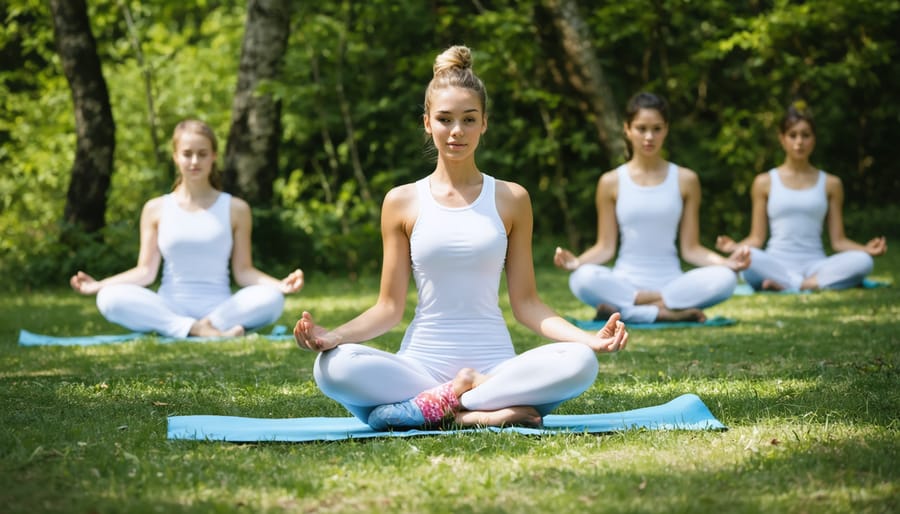Step outside into nature’s embrace for just 30 minutes daily to significantly reduce anxiety and depression symptoms, according to recent research from the University of British Columbia. Walking through local parks, hiking forest trails, or simply gardening in your backyard triggers the release of mood-enhancing neurochemicals while lowering cortisol levels by up to 20%. These outdoor activities offer a powerful, accessible way to boost mental wellness without medication or costly interventions.
The combination of natural light, physical movement, and connection with nature creates a triple-therapy effect that mental health professionals increasingly prescribe as a first-line treatment for mild to moderate mental health concerns. Research shows that people who regularly engage in outdoor activities report 40% better sleep quality and demonstrate increased resilience to daily stressors.
Whether you’re facing anxiety, depression, or simply seeking to enhance your emotional well-being, incorporating outdoor activities into your daily routine provides an evidence-based path to better mental health. Let’s explore specific activities and strategies that can help you harness nature’s healing power.
How Nature Impacts Your Mental Well-being
The Science of Nature and Mental Health
Scientific research consistently shows that spending time outdoors triggers positive changes in our brain chemistry and stress response systems. When we’re in nature, our bodies reduce the production of cortisol, often called the stress hormone, while increasing the release of mood-boosting endorphins and serotonin.
The natural light exposure during outdoor activities helps regulate our circadian rhythm, improving sleep patterns and overall mental well-being. Studies have found that even 15 minutes of forest bathing can lower blood pressure, decrease anxiety levels, and improve concentration.
The combination of fresh air, natural sounds, and green spaces activates our parasympathetic nervous system – our body’s “rest and digest” mode. This activation helps counter the effects of chronic stress and mental fatigue. Research from Canadian universities has shown that people who regularly spend time in nature report fewer symptoms of depression and anxiety, and demonstrate better emotional regulation.
Benefits for Anxiety and Depression
Research consistently shows that outdoor activities can significantly reduce symptoms of anxiety and depression. When you spend time outside, your body produces more serotonin, often called the “feel-good” hormone, which naturally helps improve mood and reduce stress levels. The combination of physical activity and natural settings triggers the release of endorphins, creating a natural antidepressant effect.
Sunlight exposure during outdoor activities helps regulate your body’s production of vitamin D and melatonin, which play crucial roles in mood regulation and sleep patterns. Studies have found that just 20 minutes of outdoor activity can be as effective as a dose of antidepressant medication for some people.
The calming effects of nature, combined with the mindful experience of being present outdoors, can help break cycles of negative thinking common in anxiety and depression. Regular outdoor activities have been shown to improve self-esteem, reduce rumination, and enhance overall emotional resilience, making them valuable tools in managing mental health challenges.
Top Outdoor Activities for Better Mental Health
Forest Bathing and Mindful Walking
Forest bathing, known as “shinrin-yoku” in Japan, is a mindful practice of immersing yourself in the forest atmosphere. This therapeutic approach combines gentle walking with mindful awareness of your natural surroundings, offering significant mental health benefits backed by research.
When forest bathing, you’ll engage all your senses: listen to rustling leaves, smell the earthy aromas, feel the bark’s texture, and observe the play of sunlight through the canopy. Studies show that spending time among trees can lower cortisol levels, reduce anxiety, and improve mood and concentration.
To practice forest bathing, find a quiet wooded area and walk slowly, focusing on your breathing and the natural environment. There’s no need to cover long distances – the emphasis is on being present rather than reaching a destination. Even 20 minutes of mindful walking in nature can provide mental health benefits.
For Canadians, local parks, conservation areas, and urban forests offer perfect settings for forest bathing year-round. Remember to dress appropriately for the weather and choose well-maintained trails for safety.

Gardening for Mental Wellness
Gardening is a powerful tool for improving mental wellness, combining gentle physical activity with the therapeutic benefits of connecting with nature. Research shows that tending to plants can reduce stress hormones, lower anxiety levels, and improve mood through the release of endorphins. The simple act of nurturing plants from seed to bloom provides a sense of accomplishment and purpose.
Getting started with gardening doesn’t require a large space or extensive knowledge. Begin with a few hardy plants in containers on your balcony or windowsill. Herbs like basil, mint, and rosemary are excellent choices for beginners, as they’re relatively easy to maintain and provide the added benefit of fresh ingredients for cooking.
For those with yard space, consider starting a small vegetable garden. The process of planning, planting, and maintaining your garden creates a mindful routine that can help ground you in the present moment. Even fifteen minutes of daily gardening can provide meaningful mental health benefits.
Remember to start small, be patient with yourself and your plants, and enjoy the process of learning and growing together.

Outdoor Exercise and Sports
Engaging in outdoor physical activities offers unique mental health benefits that indoor exercises simply can’t match. The combination of natural light, fresh air, and physical movement creates a powerful boost for mood and emotional well-being. Activities like jogging through park trails, cycling on scenic routes, or participating in outdoor yoga sessions can significantly reduce stress levels while increasing the production of feel-good hormones.
Many Canadians are discovering the advantages of exercising in nature, whether through organized sports or individual activities. Research shows that outdoor exercise can improve self-esteem and reduce symptoms of anxiety and depression more effectively than indoor workouts. The natural vitamin D exposure from sunlight also plays a crucial role in maintaining positive mental health.
Taking advantage of community outdoor fitness spaces can make regular exercise more accessible and enjoyable. Activities like basketball, tennis, or even casual walking groups provide both physical benefits and valuable social connections. During winter months, seasonal activities like cross-country skiing and snowshoeing offer excellent opportunities to stay active while embracing our Canadian climate.

Nature Photography and Art
Nature photography and artistic pursuits in the outdoors offer a wonderful way to combine creativity with mental wellness. When you focus on capturing the perfect shot of a sunrise or sketching a landscape, your mind naturally enters a state of mindful observation, helping to reduce stress and anxiety.
Consider starting with simple smartphone photography during your outdoor walks. Pay attention to interesting patterns in tree bark, the play of light through leaves, or the vibrant colours of wildflowers. This practice encourages you to slow down and truly observe your surroundings, promoting a deeper connection with nature.
For those interested in traditional art, try finding a peaceful spot in a local park to sketch or paint. Bring along a small notebook and pencils or portable watercolours. The act of creating art outdoors combines the calming effects of nature with the therapeutic benefits of creative expression.
Both activities can be enjoyed year-round in Canada’s diverse landscapes, from capturing the golden hues of autumn to sketching snow-covered scenes in winter. These creative pursuits also provide a tangible record of your outdoor experiences, serving as lasting reminders of peaceful moments in nature.
Getting Started: Practical Tips
Creating an Outdoor Routine
Establishing a consistent outdoor routine doesn’t have to be complicated. Start by choosing activities that genuinely interest you and match your current fitness level. Consider beginning with just 15-30 minutes of outdoor time each day, gradually increasing as it becomes more comfortable.
Set specific days and times for your outdoor activities, treating them as important appointments in your schedule. For example, you might plan morning walks before work on weekdays or weekend afternoon nature photography sessions. Having a structured schedule makes it easier to maintain your routine and creates accountability.
Make your routine more sustainable by:
– Starting small and building gradually
– Preparing proper clothing and gear in advance
– Having indoor backup activities for severe weather
– Finding an outdoor activity buddy
– Tracking your progress through a journal or app
Consider connecting with local health resources to discover organized outdoor programs and group activities in your area. Many communities offer guided nature walks, outdoor fitness classes, and seasonal activities that can add variety to your routine.
Remember to adjust your routine based on seasonal changes, especially during Canadian winters. This might mean shifting activity times to daylight hours or adapting activities to snow conditions. The key is maintaining consistency while being flexible enough to accommodate weather and seasonal variations.
Safety and Preparation
Before heading outdoors for your mental wellness activities, proper preparation is essential for a safe and enjoyable experience. Start by checking the weather forecast and dressing appropriately in layers, especially during Canada’s variable weather conditions. Always inform someone about your planned location and expected return time, particularly when venturing into remote areas.
Carry essential items including water, healthy snacks, a basic first-aid kit, and a fully charged mobile phone. If you’re new to outdoor activities, consider joining community wellness programs that offer guided experiences and safety instruction.
For activities in natural settings, familiarize yourself with the area beforehand and stick to marked trails when hiking or exploring. Apply sunscreen and wear appropriate protective gear, such as a hat and sturdy footwear. During winter months, pay special attention to ice conditions and wear proper winter gear to prevent cold-related injuries.
If you have any pre-existing health conditions, consult your healthcare provider before starting new outdoor activities. Start gradually and listen to your body’s signals. Remember that mental health benefits come from consistent, sustainable practice rather than pushing yourself too hard too quickly. Stay within your comfort zone while gradually building your confidence and capabilities in outdoor settings.
Embracing outdoor activities is a powerful way to support your mental well-being, offering natural stress relief and mood enhancement through connection with nature. Whether you choose hiking through local trails, gardening in your backyard, or simply taking a daily walk in your neighbourhood park, these activities can significantly impact your mental health. Remember that every step outside is a step toward better mental wellness – you don’t need to start with ambitious goals. Begin with just 15 minutes daily and gradually increase your outdoor time as it becomes part of your routine. The combination of physical activity, fresh air, and natural surroundings creates a perfect environment for mental rejuvenation. Make the commitment today to prioritize your mental health by spending more time outdoors, and you’ll likely find yourself feeling more balanced, focused, and emotionally resilient. Your mind and body will thank you for making this positive change.

